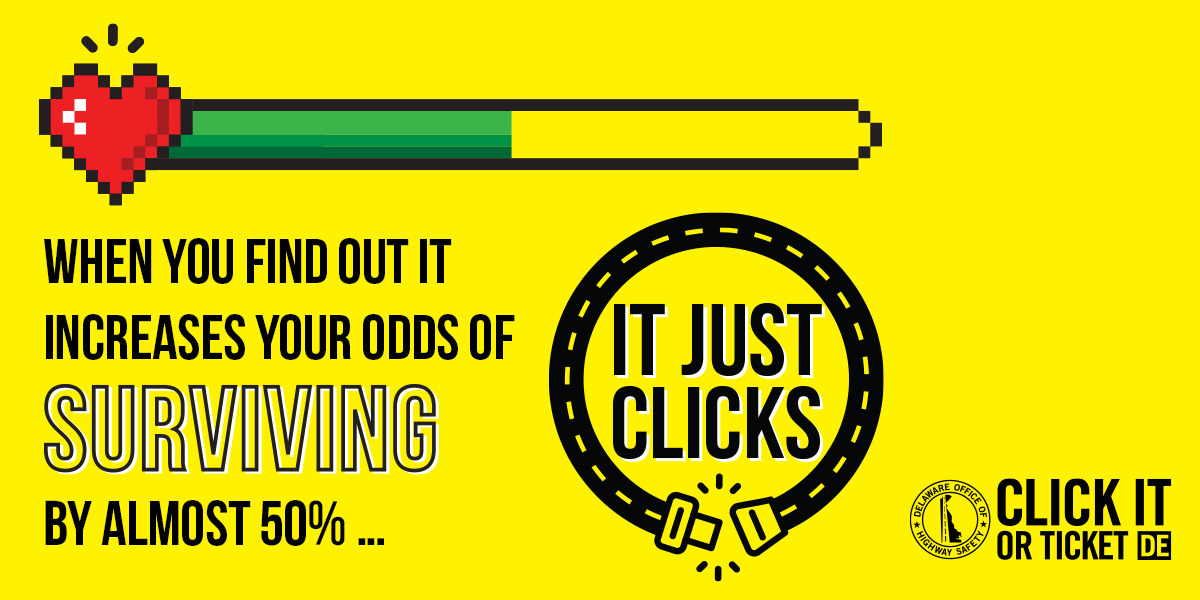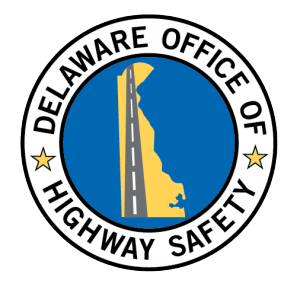Click It or Ticket Campaign Reminds Drivers: Buckle Up Every Trip, Every Time
News | Office of Highway Safety | Date Posted: Thursday, May 19, 2022
News | Office of Highway Safety | Date Posted: Thursday, May 19, 2022

DOVER, Del. (May 19, 2022) — The Delaware Office of Highway Safety (OHS) is reminding drivers about the lifesaving benefits of wearing a seat belt this spring, during the National Highway Traffic Safety Administration’s (NHTSA) national Click It or Ticket high-visibility enforcement effort. Delaware is joining the national seat belt campaign, which coincides with the Memorial Day holiday and runs from May 20 to June 5, 2022.
For this year’s Click It or Ticket seat belt mobilization effort, NHTSA is asking all states to participate in the kickoff event, Border to Border (B2B), a one-day, 4-hour national seat belt awareness event on May 23 that is coordinated by participating state highway safety offices and their respective law enforcement liaisons. The B2B program aims to increase law enforcement participation by coordinating highly visible seat belt enforcement and providing seat belt fact sheets for drivers at heavily traveled state borders.
For more information on the Click It or Ticket mobilization, please visit NHTSA.gov/ciot.
In Delaware, younger occupants are the most likely to be involved in unrestrained crashes. Additionally, almost twice as many males were killed in crashes compared to females. Studies show that males have a lower seatbelt usage rate than females. Of the males killed in crashes, more than half (66%) were unrestrained compared to 34% of females that were not buckled up.
“Over the past year in Delaware, 49 percent of people that were killed in crashes were not wearing a seatbelt,” said Kimberly Chesser, Director, Delaware Office of Highway Safety. “We see the results of not wearing a seat belt all the time. We see the loss of life and so often, it could have been prevented. It’s imperative we get the message out about the importance of seat belt safety to prevent these tragedies from happening.”
OHS is asking drivers and passengers across the country to please make buckling up an automatic habit. Whether you ride in the front seat or the back, and no matter which car seat or booster seat your child may use, everyone’s seat belt should be buckled every trip. Buckling up is the simplest thing you can do to limit injury or save your life during a crash.
“You may think you’re safe in a certain vehicle, or on a certain road, but the truth is, you’re safest when you buckle up, no matter what,” said Sarah Cattie, Senior Traffic Safety Program Manager. “Unfortunately, many families are suffering because their loved ones refused to follow this simple step.”
In addition to increased patrols, we want to educate drivers and passengers on the dangers of unbuckled driving and the correct way to buckle up safely:
Consequences of not wearing a seat belt
Guidelines to buckle up safely
For more information on the campaign, statistics, and education visit www.arrivealivede.com/buckle-up/

About the Delaware Office of Highway Safety
The Office of Highway Safety (OHS) is committed to improving the safety of Delaware’s motoring public by focusing on behavioral traffic safety issues, such as impaired driving, seat belt use, speeding, child passenger safety, pedestrian and bicycle safety, motorcycle safety, and teen driving issues. Follow the Delaware Office of Highway Safety on ArriveAliveDE.com, Facebook, Twitter, Instagram, and Snapchat.
Media Contact:
Delaware Office Of Highway Safety
Jason Coleman
jason.coleman@delaware.gov
302-744-2743 (office)
302-943-7293 (cell)
Related Topics: click it or ticket, OHS
Keep up to date by receiving a daily digest email, around noon, of current news release posts from state agencies on news.delaware.gov.
Here you can subscribe to future news updates.
News | Office of Highway Safety | Date Posted: Thursday, May 19, 2022

DOVER, Del. (May 19, 2022) — The Delaware Office of Highway Safety (OHS) is reminding drivers about the lifesaving benefits of wearing a seat belt this spring, during the National Highway Traffic Safety Administration’s (NHTSA) national Click It or Ticket high-visibility enforcement effort. Delaware is joining the national seat belt campaign, which coincides with the Memorial Day holiday and runs from May 20 to June 5, 2022.
For this year’s Click It or Ticket seat belt mobilization effort, NHTSA is asking all states to participate in the kickoff event, Border to Border (B2B), a one-day, 4-hour national seat belt awareness event on May 23 that is coordinated by participating state highway safety offices and their respective law enforcement liaisons. The B2B program aims to increase law enforcement participation by coordinating highly visible seat belt enforcement and providing seat belt fact sheets for drivers at heavily traveled state borders.
For more information on the Click It or Ticket mobilization, please visit NHTSA.gov/ciot.
In Delaware, younger occupants are the most likely to be involved in unrestrained crashes. Additionally, almost twice as many males were killed in crashes compared to females. Studies show that males have a lower seatbelt usage rate than females. Of the males killed in crashes, more than half (66%) were unrestrained compared to 34% of females that were not buckled up.
“Over the past year in Delaware, 49 percent of people that were killed in crashes were not wearing a seatbelt,” said Kimberly Chesser, Director, Delaware Office of Highway Safety. “We see the results of not wearing a seat belt all the time. We see the loss of life and so often, it could have been prevented. It’s imperative we get the message out about the importance of seat belt safety to prevent these tragedies from happening.”
OHS is asking drivers and passengers across the country to please make buckling up an automatic habit. Whether you ride in the front seat or the back, and no matter which car seat or booster seat your child may use, everyone’s seat belt should be buckled every trip. Buckling up is the simplest thing you can do to limit injury or save your life during a crash.
“You may think you’re safe in a certain vehicle, or on a certain road, but the truth is, you’re safest when you buckle up, no matter what,” said Sarah Cattie, Senior Traffic Safety Program Manager. “Unfortunately, many families are suffering because their loved ones refused to follow this simple step.”
In addition to increased patrols, we want to educate drivers and passengers on the dangers of unbuckled driving and the correct way to buckle up safely:
Consequences of not wearing a seat belt
Guidelines to buckle up safely
For more information on the campaign, statistics, and education visit www.arrivealivede.com/buckle-up/

About the Delaware Office of Highway Safety
The Office of Highway Safety (OHS) is committed to improving the safety of Delaware’s motoring public by focusing on behavioral traffic safety issues, such as impaired driving, seat belt use, speeding, child passenger safety, pedestrian and bicycle safety, motorcycle safety, and teen driving issues. Follow the Delaware Office of Highway Safety on ArriveAliveDE.com, Facebook, Twitter, Instagram, and Snapchat.
Media Contact:
Delaware Office Of Highway Safety
Jason Coleman
jason.coleman@delaware.gov
302-744-2743 (office)
302-943-7293 (cell)
Related Topics: click it or ticket, OHS
Keep up to date by receiving a daily digest email, around noon, of current news release posts from state agencies on news.delaware.gov.
Here you can subscribe to future news updates.